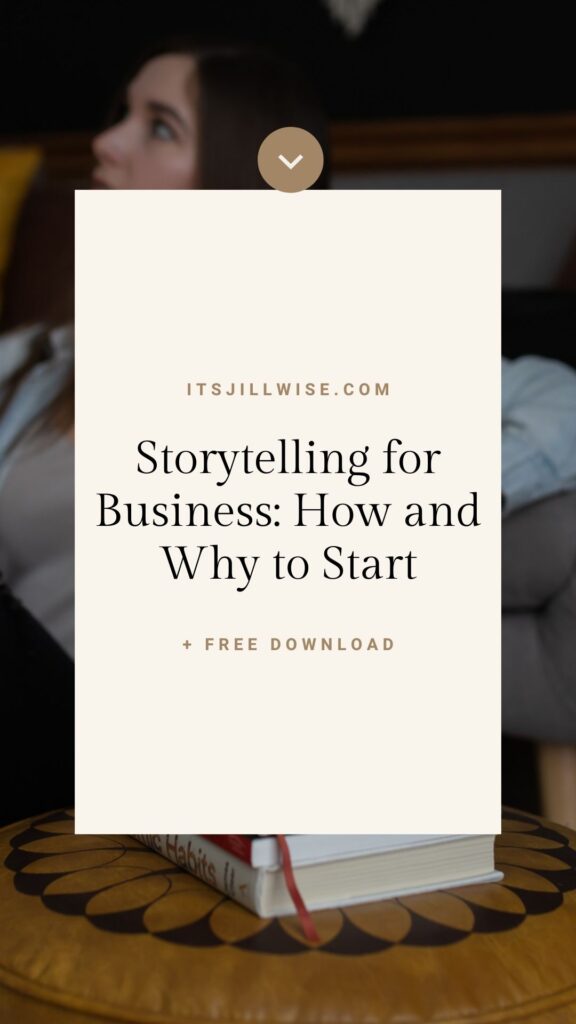Don’t sleep on this underrated marketing strategy
If you’re not leveraging the power of storytelling for business in your marketing content, you’re missing out on massive untapped potential. Stories aren’t simply leisure anymore. Especially with a consumer market that’s more sophisticated than ever, storytelling is what sets apart those who succeed from those businesses that fail.
Stories help you create a genuine connection with your audience and solidify your brand in their minds. When done well, stories are the bridge that brings people to your brand, attracting ideal clients and customers, therefore revenue.
In this post, I’ll break down the importance of storytelling for business, along with key considerations to get started. We’ll cover:
- The importance of storytelling for business, and how to leverage your brand story to foster authentic connection.
- How to hone your brand message, and develop a unique and compelling story.
- The filter to apply in order to decide what is on brand versus not relevant to your business.
- The role of social proof when storytelling for business.
- Where to learn more about storytelling for business.

Storytelling for business: Why does it matter?
Buying is an emotional reaction.
Potential buyers often ignore features and statistics. They buy something because they associate positive feelings with that brand. People then justify their purchases with the factual information.
Think about what you do when you want to purchase something: You decide, then you back up your decision to your friends or spouse based on the features of the thing. It’s the latest and greatest. You decided to buy long before knowing all those features… They just make you feel good about your choices. It’s human nature.
Look at successful advertisements. They don’t bombard their audience with their brand. They don’t just list the features of a product or service. Instead, they tell the story of the business, add to the brand’s personality, create an emotional reaction, and bring the focus back to the benefits the business can provide to the reader (even if indirectly).
This blog post was originally published in 2016, so while the example here is old, it’s still relevant.
I’ll use Budweiser’s 2014 Super Bowl Puppy Love advertisement as an example. It shows the story of a puppy and a horse becoming best friends, and the horses stopping the dog from being taken away by its adopters.
While we are oohing and aweing over the cute story, Budweiser is associating themselves with positive images in our minds. The audience does not know that it is a beer commercial until after they watch the story. The video went viral. Emotional response: Check.
Your goal is to elicit an emotional response.
Good storytelling for business creates emotional responses.
When writing copy for clients, we always start by developing the brand message. Essentially:
- What do you stand for, and why?
- Why should your clients or customers care about this mission?
- How does it relate to your ideal customer specifically?
- What makes you the best person to solve this problem?
- How do you make your clients and customers feel?
There’s more questions to be answered, but we use these as a starting point to create a story that is relevant and relatable to your ideal customers. People feel connected to those they see similarities with… Brands included. If they can see themselves in your brand’s story, you’re more likely to inspire the know, like, and trust factor.
We all know by now that know, like, and trust is crucial to making a sale.
Beyond these questions, you also want to tap into what your ideal customers want and need. What keeps them up at night? What are their desires? What would it mean for them to find a solution to their current challenges? The answers to these questions will help you shape your brand stories to be more relevant to them specifically.
Storytelling for business isn’t just about writing what you want to say, but writing what they need to hear.
Storytelling for business works for big and small brands.
While Budweiser is a huge brand with a much different marketing budget than most businesses, we can take a page out of their storytelling handbook. Think about your own story.
Show (don’t tell) your audience how you are just like them. Show them your similarities. Make a personal and emotional connection. Then it’s time to bring the story back to them. Appeal to their interests. Offer solutions to their problems.
Another important aspect of successful storytelling for business is staking your position: Don’t be afraid to make polarizing statements. Good marketing repels those who aren’t a good fit just as much as it attracts those who are.
Basically, if you find a way to identify with your audience, they will identify with you. And if you make it known who you’re for, it will help you filter out those you aren’t for as well.
How to decide what fits into your brand’s story
A common question that comes up when thinking about storytelling for business is this: What’s relevant to share? Especially if you’re a solopreneur, you may feel like your brand story is closely tied to your personal story. It probably is! But that doesn’t mean you need to share all the parts of you, the human being, when storytelling for business.
Typically, I recommend clients start with the above questions. But we answer these while thinking about your business as an entity separate from yourself.
For example, I think of Jill Wise as this character that goes to work every day. The Jill Wise you see on the internet is my authentic self, but I’m allowed to maintain some boundaries for myself as well. You get to see parts of me, but not all of me.
It would be confusing and overwhelming to customers if you tried to share your entire personal story as your brand’s story. Instead, you focus on the parts of your story that are most relevant to your ideal customers. What do they need to know about you and your business in order to feel good about purchasing from you?
You can curate the parts of your story that will help them feel comfortable when storytelling for business. This approach makes everything more clear for your audience, and protects your boundaries as well.
Your story is unique and deserves to be shared
When starting to get into storytelling for business, a common challenge business owners, freelancers, and solopreneurs face is learning and realizing that their story is unique. You have something special to share that will inspire genuine connections with your audience. It’s a matter of figuring out what makes the most sense to share for yourself and your ideal customers.
The role of social proof when storytelling for business
This one is an extra bit that can be added selectively to back up chapters of your story. Was a customer thrilled with your above-and-beyond service? Can they not get enough of your product? Ask them to tell others about their experience in the form of a testimonial. Use this to support the claims you make.
For example, instead of saying something boring like “we have great customer service,” on your website, you can share the process of working with you with concise steps. Then use a testimonial that talks about how easy and enjoyable it was to work with you. That social proof will speak louder than any copy you can write.
Especially in the digital age where influencers rule, people look for the opinions and experiences others before purchasing. If you don’t work with popular influencers, testimonials are a simple way to prove the legitimacy of your brand.
Types of social proof to use in storytelling for business
Social proof doesn’t just mean written testimonials. You can collect all kinds of social proof. Here’s a few ideas:
- public reviews on your social pages and websites
- screenshots from happy customers who send you messages and emails
- case studies published on your blog
- video testimonials
- fireside chats or video interviews with clients and customers
- referral partners, and their experience working with you
These each can be optimized through your marketing and sales efforts to make people more comfortable purchasing.

Storytelling for business should be fun and engaging
Even though you’re writing for business or your brand, it needs to be interesting. Don’t make your business story read overly dry or academic. It can be fun, engaging, personable, and casual.
Typical stories have a main character. They follow a plot, and include a beginning, middle, and end. The voice telling the story is the voice you chose for your brand. The theme of the story makes sense for the audience and keeps them engaged.
Don’t just start throwing content around. Carefully select the elements of your story that are appropriate to tell in each chapter.
All stories possess persuasive powers. Buyers remember stories. Buyers respond to a well-told story generously. If they believe in your business’ story, they don’t look for faults—they just buy.
Storytelling is a timeless business asset.
While the term storytelling might seem like the latest fad in marketing, the story is a timeless asset for your business. Marketing teams have practiced the method for years. Despite the importance of storytelling in business, many ignore this marketing strategy only because they don’t know where to start. Bad idea.
The good news for you is that if you focus on honing your brand’s story, you’re already likely to stand out, even in a saturated marketing. When so many businesses ignore a strategy like this, just starting already helps you get ahead.
In a market where consumers are more sophisticated than ever, and also tired from the digital age, you need to look for ways to stand out. You need to find ways to connect authentically. That’s what this is… Storytelling for business is a tool to connect with people as human beings.
Stories have been part of cultures for ages. It makes sense that this is a strategy to help businesses stand out too.

Get support writing your brand’s story
I get it—storytelling for non-writers can feel overwhelming. Especially when you’re busy with the daily operations of your business. Where do you start? What should you say? I promise that it can be easy. With the right support, you’ll have clear answers to those questions.
There are plenty of resources available in The Biz Bar designed to help you write engaging and effective copy for your marketing needs: Weaving your brand story through your website copy, email marketing, client communications and more.
If you’re starting from scratch and don’t even know what makes you unique or what your brand message will be, I recommend starting with 4 Steps to Profit. It’s entirely free and will help you identify what makes your business unique.
Good writers are avid readers
I’ve gained so much as a copywriter, and writer in general, from reading. I don’t just look at copy written by other marketing professionals, but also books. Yes, it’s great to study your competitors and inspiration to see what they’re doing well (and not well) when storytelling for business. But there’s also so much you can gather from other areas of study. Books, both business and otherwise, will help you learn what makes a good story. So if you want to be a better writer for your business, my first recommendation is always to become a better reader.
Additional resources: Storytelling for business
Of course I’m biased, but my blog is a great place to dig into all things marketing and copywriting, along with business ownership and self-employed lifestyle.
If you want to keep learning more about what makes good copy, and storytelling for business, check out these blog posts:
- What is Brand Strategy?
- Marketing Strategy: Low-Lift and Long-Term
- How to Write Website Copy that Sells
- Brand Personality and Brand Voice
- How to Write Copy for a Website
I wish you the best of luck as you work to improve your storytelling for business, and I hope you see the benefits from your efforts quickly!
Have questions? Leave them in the comments below!
Related
Leave a Reply Cancel reply
Leave your info below to join the list. I send a lot of emails because people love to read them.
